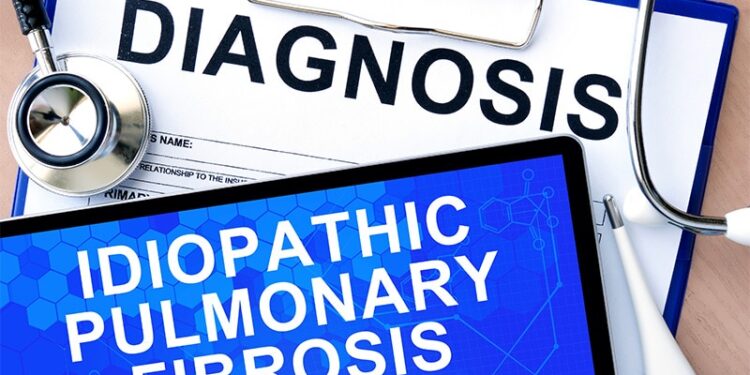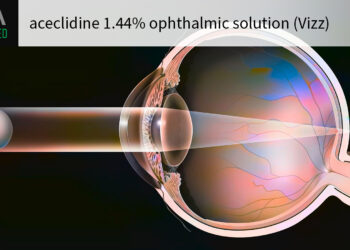SAN FRANCISCO — A molecular variant of an older, hard-to-tolerate antifibrotic agent showed promise for reducing decline in forced vital capacity (FVC) over 26 weeks among patients with idiopathic pulmonary fibrosis (IPF).
These findings come from the phase 2B ELEVATE IPF trial, results of which were reported at the American Thoracic Society (ATS) 2025 International Conference here.
The trial compared the investigational agent deupirfenidone to placebo for protection against FVC decline in 257 patients with IPF.
The deupirfenidone molecule is nearly identical in conformation to pirfenidone, except for the substitution of hydrogen in pirfenidone for deuterium, or “heavy hydrogen,” in deupirfenidone at the site of metabolism.
This process, known as “deuteration,” is designed to make the modified compound less toxic than pirfenidone, said lead investigator Toby Maher, MD, PhD, from the Keck School of Medicine at the University of Southern California, Los Angeles.
Although the primary endpoint of the study was decline in FVC over 26 weeks, “when we’ve looked at the open-label extension of patients continuing on the high dose, we’ve seen a sustained stabilization in FVC over 52 weeks, again suggesting a durable effect of treatment,” he said in an oral abstract session.
Multinational Trial
In the ELEVATE IPF trial, 257 patients with IPF from 87 sites in 14 countries were enrolled and randomly assigned to one of four treatment arms: 550 mg deupirfenidone thrice per day, 825 mg deupirfenidone thrice per day, 801 mg pirfenidone thrice per day, or placebo thrice per day.
The primary Bayesian analysis showed that the mean adjusted change in FVC from baseline to 26 weeks was −48.4 ml for all patients randomized to deupirfenidone compared with −110.7 ml for patients assigned to placebo (posterior probability vs placebo, 98.5%).
The respective adjusted mean changes from baseline in FVC% predicted were −48.4% and −1.1% (posterior probability, 99.6%).
In a Frequentist inference analysis, compared with placebo the higher dose of deupirfenidone but not the lower dose was associated with significantly less decline in FVC and FVC% predicted. The adjusted mean changes over baseline were −21.5 ml for the 825 mg deupirfenidone group vs −112.5 ml for the placebo group (P = .02), and the respective changes in FVC% predicted were −21.5% and −3.43% (P = .01).
Both pirfenidone and deupirfenidone 825 mg (but not 550 mg) significantly delayed time to progression compared with placebo. The respective hazard ratios were 0.50 (P = .0076) and 0.439 (P = .0033).
In the placebo, pirfenidone, deupirfenidone 550 mg and 825 mg arms, respectively, treatment-emergent adverse events commonly associated with antifibrotics were nausea (7.7%, 27.0%, 16.9%, 20.3%), dyspepsia (3.1%, 22.2%, 12.3%, 14.1%), diarrhea (9.2%, 11.1%, 10.8%, 7.8%), abdominal pain (4.6%, 7.9%, 6.2%, 14.1%), photosensitivity reaction (0%, 7.9%, 6.2%, 7.8%), decreased appetite (7.7%, 14.3%, 18.5%, 20.3%), fatigue (1.5%, 11.1%, 7.7%, 9.4%), dizziness (3.1%, 7.9%, 9.2%, 12.5%), and headache (4.6%, 12.7%, 7.7%, 3.1%).
GI Signal
In the question and answer, session co-moderator Rachel Knipe, MD, from Massachusetts General Hospital in Boston, commented that there appeared to be a small signal for increased abdominal pain with deupirfenidone but less so for diarrhea and other gastrointestinal symptoms. She asked Maher whether investigators had also looked at liver function tests.
“The liver function tests didn’t flag up as an adverse event that differed across groups or reached the threshold for inclusion in the table,” Maher said.
Maher acknowledged that there are gastrointestinal events associated with the drug, but added that it’s difficult to distinguish specific events from one another.
“The challenge with clinical trials in interpreting adverse events is that we are beholden on the individual investigators to label the side effects,” he said, noting that one center’s dyspepsia, may be another center’s loss of appetite or abdominal pain.
In an interview, Medscape Medical News asked Knipe, whose laboratory at Mass General has a special focus on PF, for her impression of deupirfenidone.
“I think the data looks pretty good; it’s exciting, and it looks like it has good effect on lung function,” she said, adding that the adverse event profile appears to be more favorable than that of pirfenidone.
The study was funded by PureTech Health. Maher reported receiving grants and funding and serving as a consultant for the company and others. Knipe had no disclosures relevant to the study.
Neil Osterweil, an award-winning medical journalist, is a long-standing and frequent contributor to Medscape Medical News.
Source link : https://www.medscape.com/viewarticle/deupirfenidone-shows-promise-against-ipf-linked-lung-decline-2025a1000dkn?src=rss
Author :
Publish date : 2025-05-28 12:37:00
Copyright for syndicated content belongs to the linked Source.














